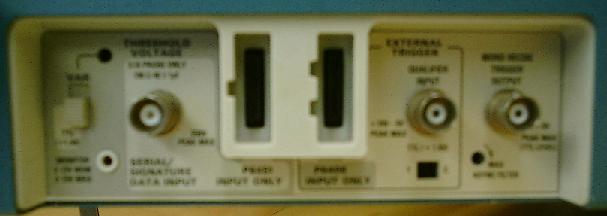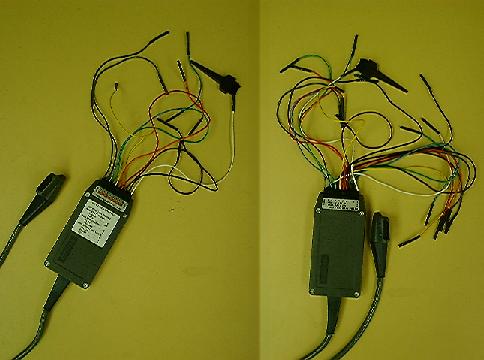Tektronix 308 Data Analyzer
by
William Ho
&
Alan Chu
Modes of operation
Timing analysis of parallel
signals
State analysis of parallel
signals
Serial / Signature analysis
Controls and Indicators
Power Up
Inputs
Triggering
Data Acquisition
Displaying Data
Comparing Data
Quiz
Lab Exercise
The Tektronix 308 Data Analyzer has four modes of operation:
The Data Analyzer is similar to a logic analyzer functionally. However,
its ability to analyze parallel signals makes it far superior than the
rivalry logic analyzer. (back to TOP)
Timing analysis of parallel signals
The 308 provide an 8-channel input, a 20 MHz clock speed, and 52-bits/channel memory size when used as a Parallel Timing analyzer.
The eight channel (expandable to 24 channel) parallel word recognizer triggers upon recognition of a preset digital word. If no preset data is presence, the 308 immediately and automatically generates an internal trigger at the start of an acquisition. Data sampling rate ranging from 50ns to 200ms (20 MHz to 5 Hz). An external clock or trigger signal can also be introduce to the 308 (via the Qualifier Input) as a synchronous sampling reference. The latch input allows the 308 to capture glitches narrow than the sample interval. Stored data is displayed on the CRT on digitized timing format representing the HI and LO levels of the stored data, but not the actual waveform. (back to TOP)
State analysis of parallel signals
The parallel state analyzer function is identical to the parallel timing Analyzer function except for the display. Data is displayed in binary, octal and hexadecimal formats. (back to TOP)
For Serial / Signature analysis, please visit my classmate’s web page on Logic Analyzer. (back to TOP)
1. DATA= — Programs instrument to receive data trigger.
2. EXT= — Programs instrument to receive external trigger word.
3. DELAY= — Programs instrument to receive clock delay setting.
4. & 5. SAMPLE INTERVAL FASTER/SLOWER — These controls select the sample interval of internal clock and clock edge of external clock. Sample interval is sequenced through 23 positions in parallel mode and 17 positions in serial state mode.
6. STORE DATA—>REF — Causes data memory contents to be duplicated in the reference memory.
7. START — Starts acquisitions process.
8. STOP — Stops acquisition process with manual stop trigger.
9. RE-START IF DATA=REF — Starts and restarts acquisition process of valid portion of new data memory contents are equal to the valid portion of the reference memory content.
10. & 11. POSITION — Moves window or cursor to earlier or later position. If key is pressed and held, position steps automatically.
12. CURSOR — Chooses cursor display in parallel timing, parallel state, and serial state modes.
13. WINDOW — Chooses window display in parallel timing mode.
14. SEARCH= — Chooses compare display in parallel and serial state modes.
15. COMPARE — Chooses compare display in parallel and serial state modes. Highlights the data which differs form data in the reference memory in inverse video.
PARALLEL TIMING — Selects 8 channel parallel input signal to be stored and displayed in timing format.
PARALLEL STATE — Selects 8-channel parallel input signal to be stored and displayed in hexadecimal, binary and octal formats. (back to TOP)
At power up, the 308 automatically perform a self-diagnostic procedure. If no errors are detected, the Parallel Timing Menu will be displayed. Otherwise, service is required. (back to TOP)

P6451 INPUT ONLY — The data acquisition probe can only be connected to this connector. The eight parallel bits of data acquired by the data acquisition probe are processed differently than the serial data; however, the data is stored in the data memory and display in the same manner.
P6406 INPUT ONLY — The Word Recognizer probe can only be connected to this connector. It can be used to expand the 308 trigger capabilities. Keep in mind only the eight data bits acquired by the Data Acquisition probe will be stored and displayed.
EXTERNAL TRIGGER QUALIFIER INPUT and T/C — This input can be used in several manners depending on the position of the T/C (Trigger/Clock) switch. Word recognition capabilities are extended when set to T. (back to TOP)

Any one of the eight inputs can be used as the trigger. Using the DATA= menu can specify trigger condition to set to either HI, LO or X (don’t care). An external trigger may also be used. (back to TOP)
When the 308 is in the Sample mode, an internal or external clock can be used as the sample rate generator. Sample is taken at the pre-defined sample time; therefore the 308 may miss little glitches. On the contrary, glitches may be found and displayed by using the Latch mode. (back to TOP)
The PRE and POST key can be used to scroll the screen content horizontally. A single cursor can also be used to interpret the timing diagram into hexadecimal, octal, decimal or binary format. (back to TOP)
Data Memory copied into the Reference Memory can be compare to any later Data Memory contents by using the COMPARE key. Any difference found is highlighted in inverse video. (back to TOP)
1. What is the maximum number of channels can the Tektronix 308 capture?
A. 8
B. 16
C. 24
2. How many cursor(s) does the Tektronix 308 have?
A. 1
B. 2
C. 4
3. The Tektronix 308 is better than the Logic Analyzer because it can analyze:
A. Serial signals
B. Parallel signals
C. Radio frequencies
4. Which keys are used to scroll the screen horizontally?
A. POSITION keys
B. FAST / SLOW
C. PRE / POST
5. What is the maximum (internal) sampling rate for the Tektronix 308?
A. 1024 BPS
B. 20 MHz
C. 256 kW/Hr
6. Which two modes does the Tektronix 308 use to capture data?
A. Sample and Latch
B. Sample and Hold
C. Sample and Release
7. What is the function of the COMPARE key?
A. Compare data on two channels
B. Compare new data to data in the Reference Memory
C. Compare data with other compatible Data/Logic Analyzer
8. The cursor can be used to interpret the timing diagram into which formats?
A. Binary, Octal, Decimal, Hexadecimal
B. BCD, Octal, Decimal, Hexadecimal
C. Binary, BCD, Octal, Decimal
9. What is the function of the SEARCH key?
A. Search for glitches
B. Search for any new channel to display
C. Search and locate a byte in the Data Memory
10. What is the function of the STORE DATA—>REF key of the 308 data analyzer?
A. Copy and store data memory to the Reference Memory
B. Reference to an address of stored data
C. Refresh stored data
Answers: 1.C 2.A 3.B
4.C 5.B 6.A 7.B 8.A
9.C 10.A
(back to TOP)
Verify DeMorgan's Theorem
1. Construct circuits as per schematics:

2. Connect probes to the output, the 2 inputs and the common point.
3. Set clock to appropriate frequency (range of 1 kHz to 10 kHz is suggested favorably).
4. Generate truth table from data observed on the 308.
5. Compare results to the AND/OR truth table and verify DeMorgan's Theorem.